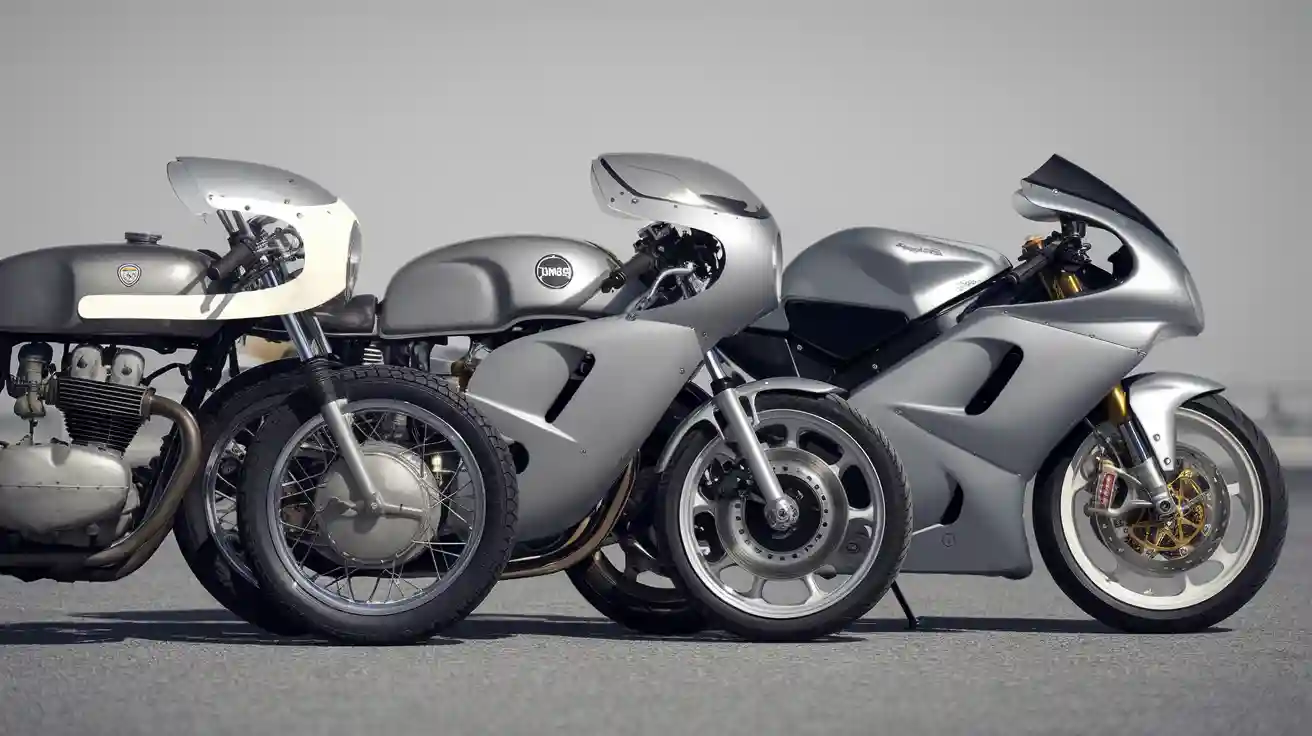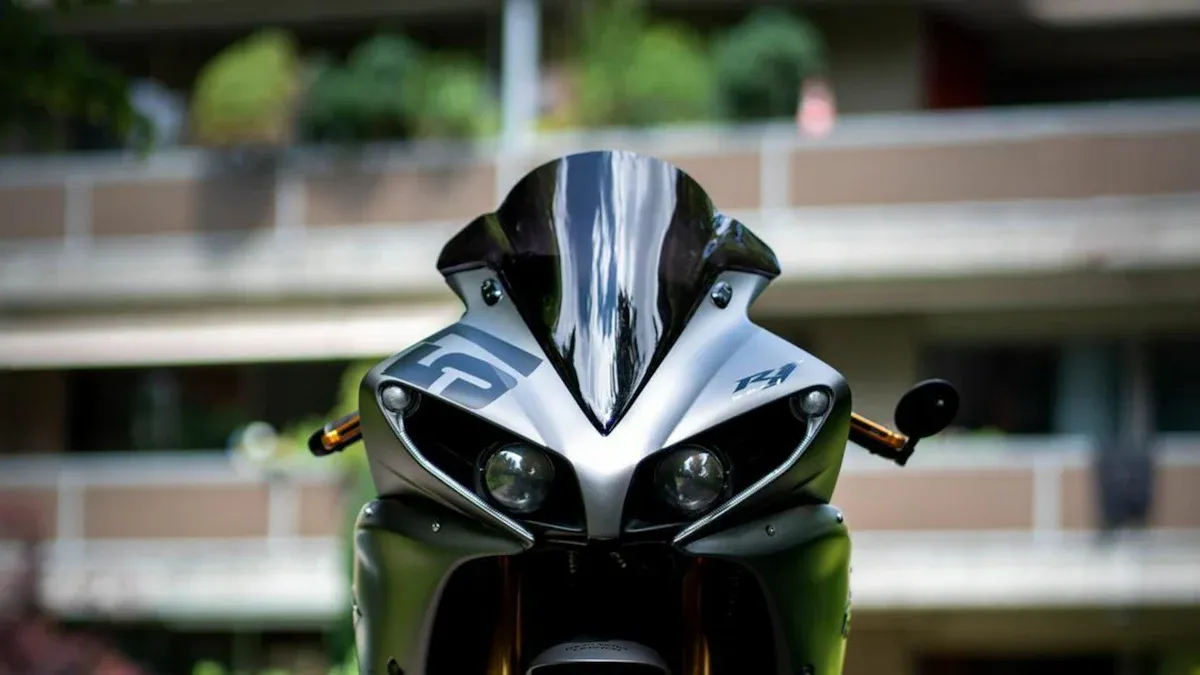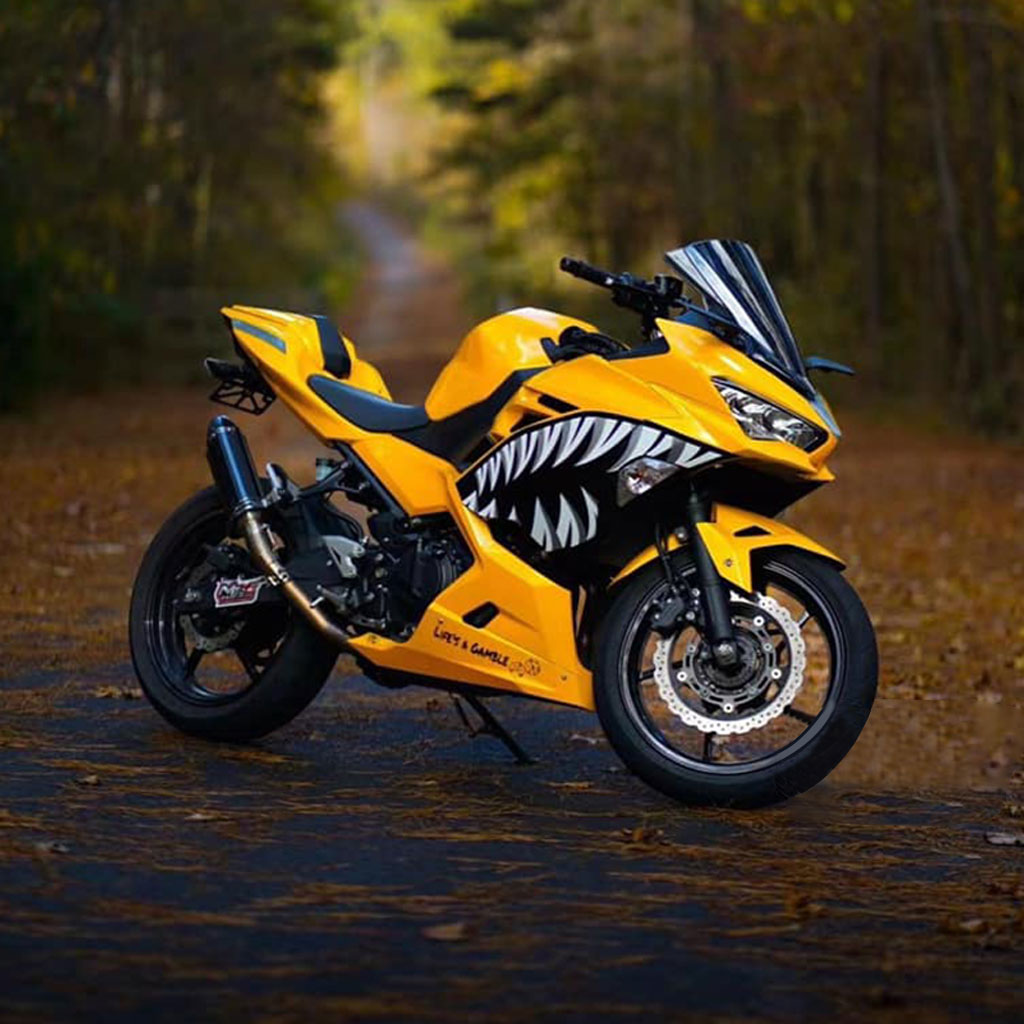Tracing the Evolution of Fairings on a Motorcycle from Racing Roots to Modern Rides

Fairings on a motorcycle help riders cut through the wind. Riders often choose a fairing to improve speed and stability. These parts also shield the rider from rain and road debris. Designers use fairings on a motorcycle to shape the look and feel of each model. A fairing can lower noise and make long trips more comfortable. Riders notice the difference every time they get on the road.
The Modern Importance of Fairings on a Motorcycle
Performance Benefits of Aerodynamic Bodywork
Aerodynamic bodywork plays a major role in modern motorcycle performance. Engineers design fairings on a motorcycle to reduce drag and help the bike move through the air with less resistance. This aerodynamic design allows riders to reach higher speeds while using less engine power. Riders notice that upgraded motorcycle fairings can lead to better fuel efficiency and smoother rides.
- Upgraded aerodynamic bodywork reduces the drag coefficient, which means the motorcycle can go faster with the same amount of power.
- Carbon fiber fairings lower the weight of the bike by 5–10 pounds. This weight reduction improves handling and acceleration.
- Improved fairing design helps reduce helmet buffeting and wind resistance. Riders feel less tired after long rides.
- The Yamaha YZF-R1M uses carbon-fiber fairings and achieves a 5% improvement in aerodynamic efficiency. This change leads to faster lap times.
- Track riders like Mark have seen their lap times drop by over a second after switching to full carbon race fairing kits. These changes improve stability and cornering.
Aerodynamic motorcycle design also helps the engine stay cool. Fairings direct airflow to the engine, which keeps it from overheating during long rides. Full fairings with vents improve acceleration by guiding air where it is needed most. These features show how aerodynamic bodywork supports both speed and fuel efficiency.
Tip: Riders who want better motorcycle performance should look for bikes with advanced aerodynamic bodywork. These features can make a big difference in speed, handling, and comfort.
Enhancing Rider Safety and Comfort
Modern motorcycle fairings do more than boost speed. They also protect riders and make every trip more comfortable. Fairings on a motorcycle shield the rider from wind, rain, and flying debris. This protection improves rider safety and helps prevent injuries from road hazards.
- Studies show that wind noise around helmets can reach 90 dB(A) at 60 km/h and up to 110 dB(A) at higher speeds. This noise can cause fatigue and hearing problems.
- Fairing and handlebar modifications can reduce wind noise by about 5–6 dB. Even small changes help riders feel less tired.
- Riders who adjust their fairings or add windshields report less helmet buffeting and smoother airflow. These changes reduce wind fatigue and make long rides easier.
- A rider who modified a Honda Tall Screen windshield noticed a big drop in wind noise and turbulence. The ride became quieter and more comfortable.
Aerodynamic bodywork also helps keep the rider in a stable position. Less turbulence means the rider does not have to fight the wind as much. This stability reduces muscle strain and makes it easier to control the motorcycle. Many riders find that modern fairings on a motorcycle help them ride longer without feeling worn out.
Motorcycle fairings combine aerodynamic design and protective bodywork to create a safer and more enjoyable experience. Riders benefit from less noise, better weather protection, and improved comfort. These features show why fairings remain a key part of motorcycle design today.
Racing Origins and Early Aerodynamics
The First Motorcycle Fairings in Racing
Motorcycle fairings began as simple solutions for racers who wanted to go faster. In the 1920s and 1930s, riders started using basic fairings made from metal, leather, or even canvas. These early designs helped reduce wind resistance and allowed racers to reach higher speeds on the track. The main goal was to improve aerodynamics and give riders an edge in competition. As the sport grew, teams experimented with different shapes and materials. This period marked the start of using motorcycle fairings as performance tools in racing.
The "Dustbin" Fairing and Its Legacy
The 1950s brought a major change with the introduction of the "dustbin" fairing. This design fully enclosed the front of the motorcycle, covering the front wheel and creating a smooth surface for air to flow over. The dustbin fairing made a big impact on aerodynamics, helping bikes achieve high speeds with less effort. Riders in the sport noticed faster lap times and better fuel efficiency. However, the dustbin fairing also had problems. Strong crosswinds could make the bike unstable, especially on tough courses like the Isle of Man TT. Because of these safety risks, racing officials banned the dustbin fairing. Even today, experts debate its use in modern sport racing, especially in electric motorcycle events where aerodynamics play a big role.
Note: The dustbin fairing showed how much aerodynamics could change the sport, but it also proved that safety must come first.
Racing Regulations and Their Lasting Influence
Racing rules changed after the dustbin fairing era. Officials wanted to keep riders safe while still allowing new ideas in motorcycle fairings. The ban on fully enclosed fairings forced teams to find a balance between speed and control. This shift led to the open fairing designs seen in today’s sport motorcycles. Modern regulations still reflect lessons from the past. They encourage innovation in aerodynamics but always put rider safety at the center. The history of fairing rules shows how the sport continues to evolve, using both technology and experience to shape the future of motorcycle fairings.
Key Milestones in Motorcycle Fairings Development
Streamlining and the Rise of Aerodynamic Bodywork in the 1950s and 1960s
The 1950s and 1960s marked a turning point for motorcycle bodywork. Manufacturers started to focus on aerodynamic bodywork to help riders go faster and stay safer. During this time, several key advancements appeared:
- BMW and NSU introduced commercial fairings with windshields for touring motorcycles. These fairings improved wind protection and comfort.
- The "dustbin" fairing became popular in racing. This full fairing covered the front of the bike and reduced drag. However, it caused problems in crosswinds, so racing officials banned it.
- The 1960s saw the arrival of the "dolphin" fairing. This curved aerodynamic design improved stability and kept the benefits of reduced drag.
- Wind tunnel testing helped engineers refine bodywork shapes. They learned how to reduce drag and improve engine cooling.
- Harley-Davidson launched the Batwing fairing on the Electra Glide. This fork-mounted bodywork became a classic feature for touring bikes.
Note: These changes showed how aerodynamic bodywork could improve both speed and comfort for riders.
Transition from Track to Production Motorcycles
Racing has always pushed the limits of motorcycle technology. Engineers first tested aerodynamic bodywork on racing bikes to reduce drag and boost performance. As these designs proved successful, manufacturers began adding similar bodywork to production motorcycles. For example, the Yamaha YZF-R1 used full fairing and winglets inspired by racing. This shift allowed everyday riders to enjoy the benefits of advanced aerodynamic design. Racing rules continue to shape how much bodywork appears on consumer bikes, but the trend remains strong.
Iconic Fairing Designs Across the Decades
Some fairing designs have become legends in the motorcycle world. These iconic examples show how aerodynamic bodywork can shape both performance and style:
- The Ducati 1098 fairing helped transform Ducati’s image and set new standards for sportbike design.
- Suzuki’s GSX-R and Hayabusa models used aerodynamic bodywork to achieve high speeds and gain worldwide fame.
- Customization trends, such as carbon fiber bodywork and race replica fairings, let riders personalize their motorcycles.
These milestones highlight the lasting impact of aerodynamic bodywork and fairing design on the industry.
The Science of Aerodynamics in Motorcycle Fairings
Reducing Drag and Improving Speed
Aerodynamics shapes how motorcycles move through the air. Engineers design aerodynamic bodywork to lower the drag coefficient and shrink the frontal area facing the wind. This approach reduces air resistance, which increases with the square of speed. When a motorcycle uses streamlined fairings, the airflow becomes smoother. The rider’s back flattens, and the bodywork guides air around both the bike and the rider. This process leads to drag reduction and allows the motorcycle to reach higher speeds with the same engine power.
The Voxan Wattman electric motorcycle shows how effective aerodynamics can be. Its custom fairings and raised seat position helped it set a speed record of 283 mph. The fairings shaped as airfoils, with extended length and width, minimized turbulence and flow separation. Engineers also use computer simulations to test different fairing shapes. For example, replacing round forks with NACA airfoil shapes lowers drag and turbulence. A well-designed tail fairing, wider and longer than the body, can drop the drag coefficient from 0.4 to 0.25. This change makes the motorcycle more aerodynamically efficient and boosts high-speed performance.
Note: The faster a motorcycle goes, the more important aerodynamics becomes. Even small improvements in bodywork design can lead to big gains in speed and efficiency.
Stability, Handling, and Engine Efficiency
Aerodynamic bodywork does more than help motorcycles go fast. It also improves stability and handling, especially at high speeds. When fairings reduce air resistance, the motorcycle cuts through the wind more smoothly. This effect helps the bike stay steady, even when strong gusts hit from the side. Riders feel less buffeting and can control the motorcycle with greater confidence.
Different types of fairings offer unique benefits. Full fairings cover most of the bike and provide the best aerodynamic performance. They reduce wind drag, improve fuel economy, and shield the rider from wind. Half fairings balance aerodynamics with easy maneuvering, making them popular for touring and street bikes. Quarter fairings give some wind protection and comfort but offer less drag reduction.
Lightweight materials like carbon fiber make bodywork even more effective. These materials lower the weight of the motorcycle, which leads to improved stability and handling. The Yamaha YZF-R1M uses carbon-fiber fairings to achieve a 5% boost in aerodynamic efficiency. This upgrade results in faster lap times and better control during high-speed riding.
Tip: Riders who want improved stability and handling should look for motorcycles with advanced aerodynamic bodywork. These features help maintain control and comfort at high speeds.
Rider Protection from Wind and Debris
Aerodynamic bodywork also provides enhanced rider protection. Fairings shield the rider from wind, rain, and flying debris. This protection keeps the rider safer and more comfortable during every ride. By directing airflow around the rider, fairings reduce wind noise and helmet buffeting. Riders experience less fatigue and can focus better on the road.
At high speeds, air resistance can make riding tiring and even dangerous. Aerodynamic fairings help by smoothing airflow and minimizing turbulence. This design keeps the rider in a stable position and reduces muscle strain. Riders who use well-designed fairings report less wind impact and better comfort, even on long trips.
A table below shows how different types of bodywork affect rider protection and comfort:
| Fairing Type | Wind Protection | Comfort Level | Aerodynamic Benefit |
|---|---|---|---|
| Full Fairing | High | High | Maximum |
| Half Fairing | Moderate | Moderate | Balanced |
| Quarter Fairing | Low | Basic | Minimal |
Aerodynamics in motorcycle bodywork not only boosts speed and handling but also ensures enhanced rider protection from the elements. Riders benefit from reduced drag, improved stability, and a safer, more enjoyable experience on the road.
Material Innovations in Aerodynamic Bodywork
Evolution from Metal to Fiberglass and Plastics
Early motorcycle bodywork used materials like metal, leather, and canvas. These choices helped racers reduce wind resistance but offered limited protection and flexibility. As technology advanced, manufacturers began using fiberglass and ABS plastic for bodywork. Fiberglass became popular in racing because it is lighter and more durable than ABS plastic. ABS plastic offers strength, flexibility, and light weight, making it a common choice for sport bikes and aftermarket bodywork. This shift allowed designers to create more complex shapes, improving aerodynamics and rider safety. The move to fiberglass and plastics also made bodywork easier to repair and more affordable for everyday riders.
Lightweight Composites and Advanced Materials
Modern motorcycle bodywork relies on advanced materials to boost performance and durability. Fiberglass stands out for its light weight, strong resistance to impacts, and ability to handle heat. Aviofiber, a special type of fiberglass, pushes these benefits even further. It is lighter, stronger, and more flexible, making it ideal for racing bodywork. Traditional ABS plastic, while still used, cannot match the performance of these composites. The table below shows how different materials affect bodywork:
| Material | Key Properties | Performance & Durability Benefits |
|---|---|---|
| Fiberglass | Lightweight, high mechanical resistance, corrosion resistant, thermal insulation, design flexibility | Reduces motorcycle weight, improves handling and speed, resists impacts and heat, allows complex bodywork designs |
| Aviofiber | Even lighter, stronger, more flexible | Further reduces weight, increases strength and flexibility, ideal for racing bodywork |
| ABS Plastic | Heavier, less impact and thermal resistant | Less suitable for racing, lower durability, and poor thermal/fire resistance compared to composites |
These innovations help bodywork protect riders, improve speed, and last longer under tough conditions.
Computer-Aided Design and Modern Manufacturing
Designers now use computer-aided design (CAD) to shape modern motorcycle bodywork. CAD helps create precise, aerodynamic curves that reduce drag and turbulence. Designers often build full-scale clay models from CAD data, then scan these models back into digital form for accuracy. This process allows for many design changes, balancing looks, aerodynamics, and technical needs. CAD also guides laser cutting and drilling, ensuring each piece of bodywork fits perfectly. The use of CAD in bodywork design leads to better aerodynamics, more comfort, and a sleek appearance for today’s motorcycles.
Rider Experience and Customization with Fairings on a Motorcycle
Comfort, Weather Protection, and Ergonomics
Fairings on a motorcycle play a big role in rider comfort. Riders often choose a full fairing for better weather protection. This type of bodywork directs airflow over the rider, which reduces wind buffeting and resistance. Tall windshields block wind pressure, keeping the rider’s head and chest stable. Adjustable windscreens let riders change airflow to match different riding conditions. Aerodynamic fairings also improve ride stability, making long highway trips more comfortable. The 2025 Harley-Davidson Road Glide uses a Sharknose fairing, designed through wind tunnel testing. This fairing provides strong wind deflection and reduces turbulence. Riders feel less vibration in the handlebars, which increases comfort and control.
Reducing Rider Fatigue on Long Rides
Long rides can make riders tired, especially when facing strong winds. A full fairing helps by reducing drag and keeping the bike steady. Riders experience less muscle strain because the fairing shields them from direct wind. The fixed design of some fairings, like the Sharknose, lowers handlebar vibration. This stability means riders can travel farther without feeling worn out. Many touring motorcycles use these features to help riders stay alert and comfortable during extended journeys.
Tip: Riders who plan long trips should look for motorcycles with advanced fairings. These features can make a big difference in reducing fatigue and improving overall comfort.
Personalization and Aesthetic Choices
Customization lets riders express their style and improve their motorcycle’s performance. Many choose unique designs, lightweight materials, or modular fairings. Popular options include fiberglass, carbon fiber, and ABS plastic. Custom fairings can boost aerodynamics, offer better protection, and fit a rider’s ergonomic needs. Companies like Kings Motorcycle Fairings provide a wide range of color schemes and designs. Riders enjoy making their bikes stand out while also gaining durability and easier repairs. Custom fairings designed for racing can optimize airflow and reduce drag, which appeals to those who want high performance. These choices give riders a more comfortable, high-performance, and visually striking experience.
Racing Technology’s Influence on Consumer Motorcycle Fairings
Transfer of Aerodynamic Innovations from Track to Street
Racing teams often lead the way in motorcycle innovation. They test new ideas in aerodynamics and fairing design on the track before these features reach consumer bikes. Ducati, for example, first used winglets on their MotoGP racing bike, the Desmosedici, in 2015. These winglets improved stability and performance at high speeds. After two years, Ducati introduced similar winglets on their road bikes, bringing racing technology to everyday riders. The company uses powerful computers to analyze data from racing, which helps engineers quickly adapt new aerodynamic parts for street use. This process ensures that fairing designs from the sport world meet the needs of regular riders, offering better braking and cornering stability.
- Ducati’s racing division shapes the brand’s identity and sets high expectations for customers.
- Winglets and other aerodynamic features now appear on consumer models like the Panigale V4.
- Engineers test these features for safety and durability before adding them to street bikes.
Performance-Oriented Models for Everyday Riders
Manufacturers design performance-oriented motorcycles to give riders a taste of the sport experience. These models use advanced fairing designs and other features inspired by racing. The table below shows what sets these motorcycles apart:
| Feature Category | Description | Benefit for Everyday Riders |
|---|---|---|
| Engine | High horsepower and torque for quick acceleration and top speed | Fast response in daily traffic |
| Chassis | Lightweight frames made from aluminum or carbon fiber | Easy handling in city and highway riding |
| Riding Position | Sporty posture with higher foot pegs and low handlebars | Better control and less fatigue on long rides |
| Suspension | Adjustable forks and shocks for precise handling | Comfort and stability on different roads |
| Braking System | Strong disc brakes with ABS technology | Reliable stopping power in all conditions |
Naked bikes, also called streetfighters, offer a mix of sport performance and daily comfort. They lack full fairings but keep the handling and speed of sport bikes. Riders enjoy an upright position, making these motorcycles practical for commuting and travel.
Real-World Examples of Racing-Inspired Fairings
Many consumer motorcycles use fairing technology that started in racing. The Klock Werks Flare® Windshield began as a solution for high-speed racing at the Bonneville Salt Flats. Its unique shape improves airflow and stability, reducing buffeting for riders. Harley-Davidson added this windshield to their Road Glide and Street Glide models, blending racing aerodynamics with touring comfort.
The table below highlights more motorcycles that use racing-inspired fairings:
| Motorcycle Model | Racing-Inspired Fairing Features | Consumer Use Case |
|---|---|---|
| Ducati Superleggera V4 | Carbon fiber fairings, aerodynamic shape | Street-legal super sport bike |
| BMW S1000 RR | Full carbon fiber bodywork | Street-legal sport bike |
| MV Agusta Superveloce S | Thermoplastic café racer fairings | Retro-style sport bike |
| Triumph Street Triple 1200 RR | Café racer head fairing | Naked/sport bike |
These examples show how sport bikes and touring motorcycles benefit from racing technology. Riders get better aerodynamics, improved comfort, and a true sport experience on the road.
Current Trends and the Future of Aerodynamic Bodywork

Smart Fairings and Integrated Technology
Motorcycle technology continues to advance quickly. Manufacturers now use integrated fairings that combine smart features with aerodynamic shapes. Many 2025 motorcycles include Adaptive Ride Control systems. These systems use sensors to monitor traction, lean angle, and road conditions. They help riders stay safe by adjusting settings in real time. Vehicle-to-vehicle communication lets motorcycles share data with nearby cars and trucks. This technology improves visibility and helps prevent accidents. Riders also benefit from helmet displays that show speed, GPS, and calls right on the visor. Biometric ignition systems use fingerprints or face recognition to start the bike and load personal settings. Customizable dashboards update over the air, just like smartphones. AI-powered systems help with collision avoidance and adaptive cruise control. Smart fairings now use lightweight composites and house sensors, cameras, and even predictive maintenance tools. These features make riding safer and more enjoyable.
Sustainability and Eco-Friendly Materials
Sustainability shapes the future of motorcycle fairings. Manufacturers use bioplastics made from corn starch, sugarcane, or algae. These materials are lightweight, strong, and compostable. Companies like Zero Motorcycles use bioplastics in body panels and dashboards. Some brands mix natural fibers such as jute, hemp, or flax with biopolymers to create strong, eco-friendly composites. BMW has tested jute composites for fairings. These choices lower carbon emissions and reduce environmental impact. Many riders now prefer motorcycles made from sustainable materials. Over 70% of surveyed riders say they would choose eco-friendly options. Manufacturers also explore 3D printing and bioengineered materials to make fairings even greener.
The Next Generation of Motorcycle Aerodynamics
The next wave of aerodynamic motorcycle design uses advanced tools like Computational Fluid Dynamics (CFD). Engineers test airflow around integrated fairings virtually before building real parts. CFD helps improve cooling, stability, and rider comfort. Designers now blend aerodynamic features into the bike’s shape instead of adding them later. Wing profiles built into fairings increase downforce and stability. New fairing shapes direct air to cool the engine and protect the rider. Wider seats and reshaped tanks improve comfort and control. These changes make motorcycles safer, faster, and more stylish.
Motorcycle fairings remain essential for riders who value performance, comfort, and style. They shape modern motorcycle design by improving aerodynamics, reducing drag, and protecting both rider and machine. Manufacturers continue to innovate with new materials and features, meeting the needs of different riding styles.
- Fairings blend form, function, and innovation.
- They offer better fuel efficiency, stability, and safety.
- Customization and advanced technology make each ride unique.
Riders can appreciate how fairings combine engineering and design to create a safer and more enjoyable experience on every journey.
FAQ
What is a motorcycle fairing?
A motorcycle fairing is a shell placed over the frame. It improves aerodynamics and protects the rider from wind, rain, and debris. Many sport and touring motorcycles use fairings for better speed and comfort.
Why do some motorcycles have no fairings?
Some motorcycles, like naked bikes, have no fairings. Riders choose these models for a lighter feel and easier handling. They also prefer the exposed look and simpler maintenance.
How do fairings affect fuel efficiency?
Fairings reduce air resistance. This helps the motorcycle move more smoothly and use less fuel. Riders often see better gas mileage on bikes with well-designed fairings.
Can riders customize their motorcycle fairings?
Yes, riders can customize fairings. They choose different shapes, colors, and materials. Custom fairings can improve style, comfort, and performance.
Are fairings only for racing motorcycles?
No, fairings appear on many types of motorcycles. Touring bikes, cruisers, and even some scooters use fairings. They help with comfort, safety, and style for all riders.
See Also
Sportbike Fairings Development From Classic Honda To Modern Ducati
Comprehensive Guide To Understanding Motorcycle Fairings Today
Unique Custom Motorcycle Fairings Crafted By Nicefairings
Nicefairings Offers Custom Fairings For Distinctive Motorcycle Styles
Top Motorcycle Fairing Customizations Every Rider Should Explore

